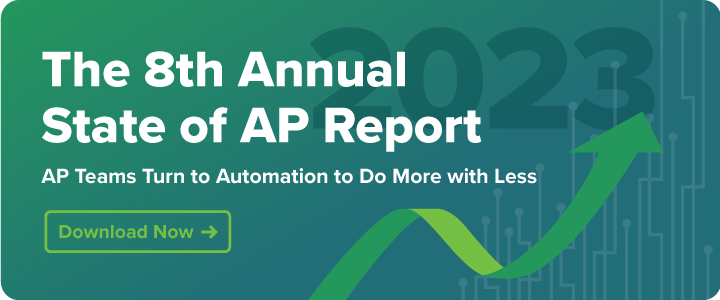As anyone who works in AP knows, tracking invoices from receipt through payment and reconciliation is a headache without the right tools and procedures. Yet finding the right invoice tracking process is crucial, as it reduces errors and simplifies the process of responding to vendor inquiries. Here we dig into the details of invoice tracking by reviewing the overall invoice management process, its importance, and the necessary steps to efficiently track invoice payments.

What is Invoice Management?
Invoice management refers to the process of tracking and moving individual invoices from receipt through payment. Proper invoice management allows accounts payable teams to quickly identify invoice payment status, without digging through stacks of paper or searching cluttered email inboxes.
While many organizations would benefit from adopting an automated AP solution to support their invoice management, less than a quarter of organizations have fully automated their AP process. This is especially relevant as 65.5% of organizations in 2022 are making more than 100 supplier payments per month. That said, the majority of today’s firms have set their sights on AP automation. In fact, research shows AP automation is now the number one priority within the finance function for 2022.
Challenges in Manually Tracking Invoices
The biggest challenges with invoice management and tracking stem from manual processes. Below are common issues with manual invoice management:
It’s Time-Consuming and Expensive
A manual invoice approval process often involves moving a paper invoice copy from desk to desk, along with repeated reminders to approvers to ensure invoices aren’t forgotten. As many of the executives approving invoices are busy, it’s commonplace for them to lose track of invoices waiting for review. When this happens, AP teams are often tasked with conducting time-consuming check-ups with approvers. Eventually, as monthly invoice volume increases, organizations can no longer scale their manual processes and must either add additional AP headcount or adopt a new tool to streamline invoice management.
But that’s not all. Once the AP team receives all invoice approvals, then they must initiate the actual payments. Manual processes typically render payments via a check sent in the mail. This can be time-consuming and expensive, since checks require teams to physically purchase, assemble, and mail postage materials with the checks.
In 2022, 33% of companies are still making over half of payments via check. As the least secure form of payment, checks can create various challenges. For example, their limited ability to track the status of payment. If a check gets lost in the mail or sent to the wrong address, teams must often scramble to cancel the old check and re-facilitate payment to the supplier. This entire process can negatively impact vendor relationships.
The Manual Process is Prone to Errors
Throughout the process, there are many places where an invoice can get lost or misplaced. Invoices can be sent via different means, such as email and mail, resulting in duplicate payments and duplicate requests for invoice approval on the same invoice. (No invoice approver likes to see the same invoice twice that they already approved.) Payment can also get lost or delayed in the mail, and manual invoice entry can be prone to human error. Today’s hybrid offices have created an additional challenge of ensuring invoices are sent to the right people at the right place.
Answering Vendor Inquiries Can Be Difficult
With so much information scattered across finance, manual invoice tracking processes can make answering vendor inquiries extremely time-consuming and tiresome. For example, if a vendor calls about a late payment, the AP team must first find the invoice, determine if it has been entered, and see where it is in the approval process. Whereas an automated process cuts down the work needed to respond to such inquiries, by housing all relevant invoice information into a single system.
Taken a step further, organizations can use a vendor portal with self-service to determine the status of their payments, without waiting to hear back from the AP team at all.
Manual Processes Don’t Scale
Companies have long suffered from labor shortages during the Coronavirus pandemic. Since November 2020, the rate of employees quitting has outpaced an organization’s ability to replace their headcount. As a result, companies are tasked to do more with fewer resources. This added strain of the “Great Reshuffle” magnifies the existing and frustrating challenge of scaling manual processes.
The Workforce Is Now a Hybrid Model
Due to the pandemic, companies must also ensure that their AP workflows are compatible with a hybrid environment. Automated processes make it easier to ensure that payments are made on time, whether employees are working from home or in the office.
AP automation platforms centralize all invoice information in a single, secure location. This enables visibility into each and every invoice, its latest status update, and when the respective vendor can expect their payment.
Why Does Visibility into the Invoice Process Matter?
Visibility into the invoice process offers many benefits, especially for growing or large organizations. Any company that undergoes significant growth, for example, will quickly find that manual invoice management just doesn’t scale and leads to all sorts of problems. Meanwhile invoice visibility from an AP automation solution can help organizations to:
Strengthen Vendor Relationships:
Vendors like to get paid in a timely manner. The more visibility AP teams have into the invoice process, the easier it is to ensure payments go out as scheduled. Moreover, AP teams can then promptly answer vendor inquiries without disrupting their entire day, or even empower their suppliers to access the status of payment independently through a supplier portal.
Increase Time Savings:
When invoice errors or delays occur, AP teams need to track down the invoice in question and determine the problem. If they don’t have visibility into the invoice process, this step can take considerable time and effort. Visibility also makes it less likely that any errors or delays occur in the first place.
Avoid Duplicate Payments:
Lack of visibility makes it difficult to determine which invoices have and haven’t yet been paid. This lack of oversight leads to errors, such as duplicate payments that take even more time and effort to correct.
Expedite Invoice Processing:
Transparent invoice approval processes quickly highlight any existing bottlenecks, making it easy to streamline the process. This ensures that invoices are processed faster, with fewer errors.
Maximize Cost Savings:
Processing and paying invoices more quickly leads to cost savings in multiple ways. First, there are fewer hours spent on processing invoices. Second, the ability to pay vendors quickly means you can capitalize on early payment discounts and other incentives.
Simplify Auditing:
Centralizing all invoice information into a single, easy-to-access location makes it much easier to reconcile and audit accounts.
Streamline the Accrual Process
Understanding what invoices are pending can make it easier to determine how much money needs to be accrued quarterly, monthly, or yearly. By having proper invoice management in place, you can easily determine which funds should hit what budget.
4 Tips for Tracking Invoice Payments
To help you get started, here are 4 tips and tricks to improve your invoice payment tracking:
1. Choose an appropriate accounting software:
The right tools enable the best work from your team. Look for accounting software that is user-friendly, embraces automation, and provides visibility into the end-to-end invoice process.
2. Ensure accurate entry:
There are many ways to capture invoices into accounting software systems. It may be done manually or automatically. Whichever method you choose, take steps to avoid entry errors that lead to tracking and processing challenges down the road. MineralTree, for example, uses OCR but couples it with a human review service for 99.5% accuracy.
3. Adopt paperless processes:
Paperless AP processes help increase visibility and speed. It becomes much easier to track and search invoices if they are stored digitally, instead of on paper.
4. Run regular reports:
If you choose the right software, it should have the ability to run and compile reports containing key KPIs such as days payable outstanding (DPO) that can provide insights into how well your processes are working. These insights can help guide you to streamline your invoice tracking techniques.
Invoice Management Case Studies
The following paragraphs offer examples of organizations that have adopted MineralTree’s AP solutions and made it much easier to manage and track invoices in the midst of extreme growth.
Forge Biologics Supports Company Growth with AP Automation
Forge Biologics, a gene therapy company, recently found itself in need of an AP solution that would support its explosive growth. The company went from 30 to 200 employees in just a year and a half and processing the associated invoices with its team of two senior executives was simply untenable. By adopting MineralTree, the company is now able to support its growth without compromising critical vendor relationships.
BrightView Health Manages More Invoices Without Increasing Headcount
BrightView Health, a provider of outpatient addiction treatment, expanded from four treatment centers to 30 in just two years. This meant a significant increase in the number of invoices the company needed to process. Manual methods could not have scaled to support this growth. Instead, the company turned to MineralTree, which proved easy to use and enabled the company to manage significantly more invoices without increasing headcount.
Affinity Dental Leverages Automation to Free Employee Time for More Specialized Tasks
Affinity Dental Management, a dental service organization, also experienced explosive growth recently due to an aggressive acquisition strategy. But this growth doubled the number of invoices that the business’s small AP team had to manage. Invoices were also decentralized, making them especially difficult to track. A solution came in the form of AP automation from MineralTree, enabling automated invoice capture and freeing up team members for more specialized tasks.
How AP Automation Can Make Tracking Invoices Easier
When looking for the right software to help with invoice tracking, consider one that offers end-to-end AP automation capabilities. Not only will this make tracking a breeze, but it streamlines all of your AP processes, thus enabling you to handle fluctuating invoice volumes without increasing overhead.
MineralTree’s Total AP automation solution helps organizations reduce processing costs by up to 80 percent, increase efficiency by eliminating manual tasks, gain more control over outgoing cash flow, and prevent fraud. Learn more by requesting a demo today.




